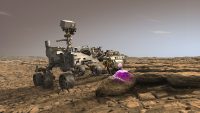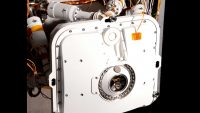PIXL requires pictures of its rock targets to autonomously position itself. Light diodes encircle its opening and take pictures of rock targets when the instrument is working at night. Using artificial intelligence, PIXL relies on the images to determine how far away it is from a target to be scanned. (NASA/JPL-Caltech)
Home PIXL requires pictures of its rock targets to autonomously position itself. Light diodes encircle its opening and take pictures of rock targets when the instrument is working at night. Using artificial intelligence, PIXL relies on the images to determine how far away it is from a target to be scanned. (NASA/JPL-Caltech) PIXL requires pictures of its rock targets to autonomously position itself. Light diodes encircle its opening and take pictures of rock targets when the instrument is working at night. Using artificial intelligence, PIXL relies on the images to determine how far away it is from a target to be scanned. (NASA/JPL-Caltech)
PIXL requires pictures of its rock targets to autonomously position itself. Light diodes encircle its opening and take pictures of rock targets when the instrument is working at night. Using artificial intelligence, PIXL relies on the images to determine how far away it is from a target to be scanned. (NASA/JPL-Caltech)




